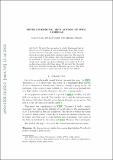| dc.contributor.author | Cuadra, Juan | |
| dc.contributor.author | Walton, Chelsea | |
| dc.contributor.author | Etingof, Pavel I | |
| dc.date.accessioned | 2018-12-12T20:54:05Z | |
| dc.date.available | 2018-12-12T20:54:05Z | |
| dc.date.issued | 2016-07 | |
| dc.date.submitted | 2016-04 | |
| dc.identifier.issn | 0001-8708 | |
| dc.identifier.issn | 1090-2082 | |
| dc.identifier.uri | http://hdl.handle.net/1721.1/119625 | |
| dc.description.abstract | We prove that any action of a finite dimensional Hopf algebra H on a Weyl algebra A over an algebraically closed field of characteristic zero factors through a group action. In other words, Weyl algebras do not admit genuine finite quantum symmetries. This improves a previous result by the authors, where the statement was established for semisimple H. The proof relies on a refinement of the method previously used: namely, considering reductions of the action of H on A modulo prime powers rather than primes. We also show that the result holds, more generally, for algebras of differential operators. This gives an affirmative answer to a question posed by the last two authors. Keywords: Hopf algebra action; Weyl algebra; Algebra of differential operators; Reduction modulo prime powers | en_US |
| dc.description.sponsorship | National Science Foundation (U.S.) (Grant DMS-1000113) | en_US |
| dc.description.sponsorship | National Science Foundation (U.S.) (Grant DMS-1502244) | en_US |
| dc.description.sponsorship | National Science Foundation (U.S.) (Grant DMS-1550306) | en_US |
| dc.publisher | Elsevier BV | en_US |
| dc.relation.isversionof | http://dx.doi.org/10.1016/J.AIM.2016.07.009 | en_US |
| dc.rights | Creative Commons Attribution-NonCommercial-NoDerivs License | en_US |
| dc.rights.uri | http://creativecommons.org/licenses/by-nc-nd/4.0/ | en_US |
| dc.source | arXiv | en_US |
| dc.title | Finite dimensional Hopf actions on Weyl algebras | en_US |
| dc.type | Article | en_US |
| dc.identifier.citation | Cuadra, Juan et al. “Finite Dimensional Hopf Actions on Weyl Algebras.” Advances in Mathematics 302 (October 2016): 25–39 © 2016 Elsevier Inc. | en_US |
| dc.contributor.department | Massachusetts Institute of Technology. Department of Mathematics | en_US |
| dc.contributor.mitauthor | Etingof, Pavel I | |
| dc.relation.journal | Advances in Mathematics | en_US |
| dc.eprint.version | Original manuscript | en_US |
| dc.type.uri | http://purl.org/eprint/type/JournalArticle | en_US |
| eprint.status | http://purl.org/eprint/status/NonPeerReviewed | en_US |
| dc.date.updated | 2018-12-04T13:54:57Z | |
| dspace.orderedauthors | Cuadra, Juan; Etingof, Pavel; Walton, Chelsea | en_US |
| dspace.embargo.terms | N | en_US |
| dc.identifier.orcid | https://orcid.org/0000-0002-0710-1416 | |
| mit.license | PUBLISHER_CC | en_US |
